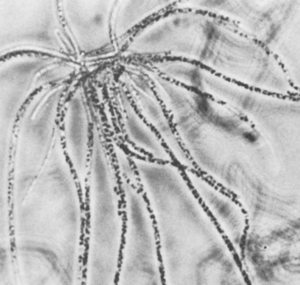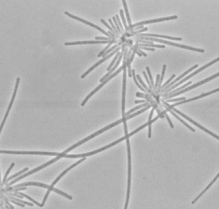Thiothrix nivea: Difference between revisions
m (→Ecology) |
|||
| (23 intermediate revisions by one other user not shown) | |||
| Line 2: | Line 2: | ||
{{Biorealm Genus}} | {{Biorealm Genus}} | ||
==Classification== | ==Classification== | ||
[[File:Thiothrix_nivea_rosette.png|thumb|Figure 1: “Rosette of T. nivea strain JP2 grown in MP broth and transferred to an agar-covered slide for photography.”<sup>4</sup>]] | |||
===Higher order taxa=== | ===Higher order taxa=== | ||
<i>[[Bacteria]]; [[Proteobacteria]]; Gammaproteobacteria; Thiotrichales; Thiotrichaceae; Thiothrix </i><sup> | <i>[[Bacteria]]; [[Proteobacteria]]; Gammaproteobacteria; Thiotrichales; Thiotrichaceae; Thiothrix </i><sup>1</sup> | ||
===Species=== | ===Species=== | ||
| Line 11: | Line 14: | ||
==Description and significance== | ==Description and significance== | ||
<i>Thiothrix nivea</i> is the type species for the <i>Thiothrix</i> genera. It was first described in 1888 by the Russian microbiologist, Sergey Nikolayevich Winogradsky. Winogradsky was one of the first evironmental microbiologists to have studied nonpathogenic microbes. At the time of <i>T. nivea</i>'s discovery he had been doing research on various types of sulfur bacteria.<sup>2</sup> <i>T. nivea</i> cells can be found in sulfur containing flowing water, such as sulfur springs, deep sea vents, and waste water treatment plants. It is not known to be pathogenic, likely due to its metabolic needs of constant sulfur flow, and to the fact that it has been found to exist in temperatures of no more than 32-34 °C.<sup>1</sup> None of which are found within the human body. | |||
==Genome structure== | ==Genome structure== | ||
<i> Thiothrix nivea</i>'s genome was completely mapped by the [http://img.jgi.doe.gov/cgi-bin/w/main.cgi?section=TaxonDetail&page=taxonDetail&taxon_oid=2506520049#browse US Department of Energy's DOE Joint Genome Institute.] The genome was found to contain about 4.7 mega-base pairs. The genome contains 4,594 total genes with 4,542 of those coding for proteins.<sup> | <i> Thiothrix nivea</i>'s genome was completely mapped by the [http://img.jgi.doe.gov/cgi-bin/w/main.cgi?section=TaxonDetail&page=taxonDetail&taxon_oid=2506520049#browse US Department of Energy's DOE Joint Genome Institute.] The genome was found to contain about 4.7 mega-base pairs. The genome contains 4,594 total genes with 4,542 of those coding for proteins, that comes out to 98.87% protein coding genes. The genome has a G/C ratio of 54.87%. <sup>3</sup> | ||
==Cell and colony structure== | ==Cell and colony structure== | ||
[[File:Thiothrix_nivea_rosettes.png|thumb|Micrograph of <i>T. nivea</i> rosettes and extending filaments.<sup>4</sup>]] | |||
<i>Thiothrix nivea</i> is a 1-1.5 | <i>Thiothrix nivea</i> is a 1-1.5 µm rod-shaped gram negative bacteria. When in the presence of sulfate or thiosulfate, sulfur granules are deposited in invaginations of the cytoplasmic membrane, external to the cytoplasm. Each cell has a tuft of fimbriae which anchors it to the cell beside it, and the colony to the substrate they may be growing on. Cells do not exhibit flagella. Cells grow and divide in a gliding motion enclosed within sheaths producing filamentous structures. When cells are clumped together, their division produces rosettes.<sup>4</sup> | ||
Cells grow and divide in a gliding motion enclosed within sheaths producing filamentous structures. When cells are clumped together, their division produces rosettes.<sup> | |||
==Metabolism== | ==Metabolism== | ||
<i>Thiothrix nivea</i> is an aerobic bacteria, producing energy both heterotrophically and autotrophically. Cells require a source of reduced sulfur compounds for an electron source, such as sulfide or thiosulfate. For a source of carbon cells need a supply of organic compounds. <sup>5</sup> Because of this, cells are considered to be an obligate mixotroph, obtaining energy from "the oxidation of sulfide or thiosulfate and carbon from CO<sub>2</sub> and organic compounds."<sup>4</sup> Sulfur is deposited within the cell in granules to be used in times of need. The organic compounds used as the sole carbon sources are acetate, malate, pyruvate and oxalacetate. Nitrogen sources were found to be ammonia, nitrate <sup>1&4</sup> and potassium nitrate.<sup>1</sup> In culture, cells do not hydrolyze starch, gelatin, or casein.<sup>4</sup> | |||
==Ecology== | ==Ecology== | ||
<i>T. nivea</i> is found free living in sulfide containing flowing waters such as sulfur springs, deep sea hydrothermal vents and is most well known for its populations in sewage waste water.<sup> | <i>T. nivea</i> is found free living in sulfide containing flowing waters; such as sulfur springs, deep sea hydrothermal vents and is most well known for its populations in sewage waste water.<sup>3</sup> <I> T. nivea has been found to thrive within an optimal pH of 7.5 and temperatures ranging from 25-30 °C. <sup>5</sup> Cells have been found to withstand temperatures of minimally 6-8 °C and maximally 32-34 °C.<sup>1</sup> | ||
==References== | ==References== | ||
1) Rossetti, Simona, Linda Blackall, et al. (2003) "Phylogenetic and physiological characterization of a heterotrophic, chemolithoautotrophic Thiothrix strain isolated from activated sludge." International Journal of Systematic and Evolutionary Microbiology. [http://ijs.sgmjournals.org/content/53/5/1271.full.pdf Journal]. DOI | 1) Bergey's Manual of Sytematic Bacteriology: Volume 2 - The Proteobacteria Part B The Gammaproteobacteria. (2005) 2nd Ed. Volume 2. New York: Springer. pp 134-141. [http://books.google.com/books?id=5zSYmcq0GdgC&pg=PA141&lpg=PA141&dq=gliding+gonidia&source=bl&ots=fiiXLxiWHo&sig=SVmnkLVMISVmLYvjY20ed4X56oQ&hl=en&sa=X&ei=oScQUcGMIaT-0gGl8IDICw&ved=0CEcQ6AEwAg Ebook] | ||
10.1099/ijs.0.02647-0 | |||
2) Encyclopædia Britannica. "Sergey Nikolayevich Winogradsky." (2013) Encyclopædia Britannica Online Academic Edition. Encyclopædia Britannica Inc. [http://www.britannica.com/EBchecked/topic/645499/Sergey-Nikolayevich-Winogradsky Encyclopædia Britannica]. | |||
3) Integrated Microbial Genomes. "Thiothrix nivea JP2, DSM 5205." (2011) DOE Joint Genome Institute. (accessed 3/13)[http://img.jgi.doe.gov/cgi-bin/w/main.cgi?section=TaxonDetail&page=taxonDetail&taxon_oid=2506520049 Integrated Microbial Genome]. | |||
4) Larkin, John, and Dean Sinabarger. (1983) "Characterization of Thiothrix nivea." International Journal ofSystematic Bacteriology. Volume 33. Issue 4. : pp 841-846. [http://ijs.sgmjournals.org/content/33/4/841.full.pdf Journal] | |||
5) Rossetti, Simona, Linda Blackall, et al. (2003) "Phylogenetic and physiological characterization of a heterotrophic, chemolithoautotrophic Thiothrix strain isolated from activated sludge." International Journal of Systematic and Evolutionary Microbiology. Issue 53, pp 1271–1276 [http://ijs.sgmjournals.org/content/53/5/1271.full.pdf Journal]. DOI 10.1099/ijs.0.02647-0 | |||
Latest revision as of 01:43, 18 May 2013
A Microbial Biorealm page on the genus Thiothrix nivea
Classification
Higher order taxa
Bacteria; Proteobacteria; Gammaproteobacteria; Thiotrichales; Thiotrichaceae; Thiothrix 1
Species
Thiothrix nivea
Description and significance
Thiothrix nivea is the type species for the Thiothrix genera. It was first described in 1888 by the Russian microbiologist, Sergey Nikolayevich Winogradsky. Winogradsky was one of the first evironmental microbiologists to have studied nonpathogenic microbes. At the time of T. nivea's discovery he had been doing research on various types of sulfur bacteria.2 T. nivea cells can be found in sulfur containing flowing water, such as sulfur springs, deep sea vents, and waste water treatment plants. It is not known to be pathogenic, likely due to its metabolic needs of constant sulfur flow, and to the fact that it has been found to exist in temperatures of no more than 32-34 °C.1 None of which are found within the human body.
Genome structure
Thiothrix nivea's genome was completely mapped by the US Department of Energy's DOE Joint Genome Institute. The genome was found to contain about 4.7 mega-base pairs. The genome contains 4,594 total genes with 4,542 of those coding for proteins, that comes out to 98.87% protein coding genes. The genome has a G/C ratio of 54.87%. 3
Cell and colony structure
Thiothrix nivea is a 1-1.5 µm rod-shaped gram negative bacteria. When in the presence of sulfate or thiosulfate, sulfur granules are deposited in invaginations of the cytoplasmic membrane, external to the cytoplasm. Each cell has a tuft of fimbriae which anchors it to the cell beside it, and the colony to the substrate they may be growing on. Cells do not exhibit flagella. Cells grow and divide in a gliding motion enclosed within sheaths producing filamentous structures. When cells are clumped together, their division produces rosettes.4
Metabolism
Thiothrix nivea is an aerobic bacteria, producing energy both heterotrophically and autotrophically. Cells require a source of reduced sulfur compounds for an electron source, such as sulfide or thiosulfate. For a source of carbon cells need a supply of organic compounds. 5 Because of this, cells are considered to be an obligate mixotroph, obtaining energy from "the oxidation of sulfide or thiosulfate and carbon from CO2 and organic compounds."4 Sulfur is deposited within the cell in granules to be used in times of need. The organic compounds used as the sole carbon sources are acetate, malate, pyruvate and oxalacetate. Nitrogen sources were found to be ammonia, nitrate 1&4 and potassium nitrate.1 In culture, cells do not hydrolyze starch, gelatin, or casein.4
Ecology
T. nivea is found free living in sulfide containing flowing waters; such as sulfur springs, deep sea hydrothermal vents and is most well known for its populations in sewage waste water.3 T. nivea has been found to thrive within an optimal pH of 7.5 and temperatures ranging from 25-30 °C. 5 Cells have been found to withstand temperatures of minimally 6-8 °C and maximally 32-34 °C.1
References
1) Bergey's Manual of Sytematic Bacteriology: Volume 2 - The Proteobacteria Part B The Gammaproteobacteria. (2005) 2nd Ed. Volume 2. New York: Springer. pp 134-141. Ebook
2) Encyclopædia Britannica. "Sergey Nikolayevich Winogradsky." (2013) Encyclopædia Britannica Online Academic Edition. Encyclopædia Britannica Inc. Encyclopædia Britannica.
3) Integrated Microbial Genomes. "Thiothrix nivea JP2, DSM 5205." (2011) DOE Joint Genome Institute. (accessed 3/13)Integrated Microbial Genome.
4) Larkin, John, and Dean Sinabarger. (1983) "Characterization of Thiothrix nivea." International Journal ofSystematic Bacteriology. Volume 33. Issue 4. : pp 841-846. Journal
5) Rossetti, Simona, Linda Blackall, et al. (2003) "Phylogenetic and physiological characterization of a heterotrophic, chemolithoautotrophic Thiothrix strain isolated from activated sludge." International Journal of Systematic and Evolutionary Microbiology. Issue 53, pp 1271–1276 Journal. DOI 10.1099/ijs.0.02647-0
Edited by Brittany N King, student of Dr. Lisa R. Moore, University of Southern Maine, Department of Biological Sciences, University of Southern Maine Biology Department Website


